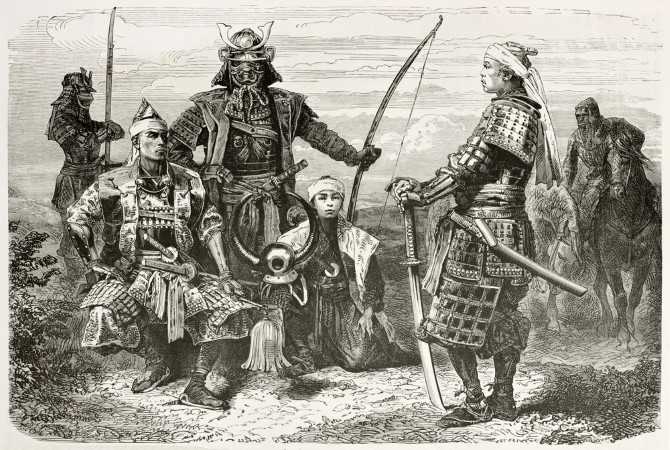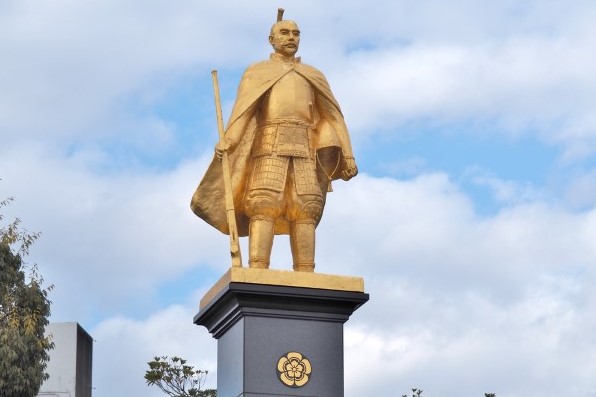
James Clavell's Shogun captivated readers with its epic tale of John Blackthorne, an Englishman caught in the political maelstrom of 17th-century Japan. While the novel takes liberties for dramatic effect, its roots lie in an incredible true story – that of William Adams, a sailor who became an unlikely confidante to a powerful warlord on the cusp of unifying a fractured nation. In this article, we will look at the TRUE history behind the celebrated book, which has gotten a second series (the first one, released in 1980, is still a terrific classic) and is once again getting a lot people interested in the this fascinating story. At the bottom is also a video about the incredible William Adams.
A World in Turmoil: The Sengoku Period

To understand Adams' story, we must travel back to Japan's Sengoku period (1467-1603), a time of almost constant warfare. For over a century, the country was fractured into a patchwork of domains ruled by daimyo, or powerful feudal lords. These daimyo were constantly vying for control, raising armies, and clashing in bloody battles. The once-unified structures of government had crumbled, replaced by a ruthless scramble for power. This era, known as the Sengoku period, was a time of great upheaval and uncertainty. It was also a period of innovation, as daimyo sought new advantages in warfare and governance. Amidst the chaos, some daimyo began to consolidate their power, conquering neighboring domains and building larger alliances. One such daimyo was a young man named Tokugawa Ieyasu, who would eventually rise above the rest and usher in a new era for Japan.
Tokugawa Leyasu, the inspiration for the famous Toranaga
Tokugawa Ieyasu's life reads like the ultimate guide to political cunning and military prowess. His journey from obscurity to the unchallenged ruler of Japan was marked by strategic alliances, calculated betrayals, and his undeniable battlefield brilliance.
Born Matsudaira Takechiyo in 1543, Ieyasu spent much of his childhood as a political hostage, shuttled between rival clans. This early experience honed his patience and his ability to read shifting loyalties, skills that would become his greatest weapons. Upon returning to his home domain, he formed a crucial alliance with the powerful Oda Nobunaga, a ruthless warlord on a mission to unify Japan. Ieyasu fought alongside Nobunaga, proving himself both a capable commander and a cunning opportunist.

A statue of Oda Nobunaga
His patience was tested when Nobunaga was assassinated in 1582. In the ensuing power vacuum, Ieyasu moved strategically, sometimes siding with Nobunaga's heir, Toyotomi Hideyoshi, sometimes challenging him. This dance of alliances and skirmishes culminated in the pivotal Battle of Sekigahara in 1600. A hugely important and famous battle, it was fought in a thick fog, with shifting loyalties and surprise defections. A pivotal moment occurred when a key general switched sides, swaying the odds in Ieyasu's favor. Leyasu's Eastern Army emerged victorious. This defeat cemented his dominance and paved the way for him to become Shogun in 1603, ushering in the long-lasting Tokugawa Shogunate that shaped Japan for centuries.
Leyasu was more than just a military genius. To maintain the hard-won peace, he implemented a system of control over the daimyos, requiring them to maintain residences in the capital and leave their families as hostages. This ensured loyalty and prevented rebellions. Additionally, he implemented a rigid social class system and instituted policies restricting foreign influence. These measures contributed to over 250 years of relative stability in Japan.

A statue of Tokugawa Leyasu
Tokugawa Ieyasu's legacy is one of a shrewd and patient leader who rose from pawn to power player. His policies shaped the course of Japanese history for centuries, and his blend of military might and political acumen solidified his place as one of the most influential figures in Japanese history. This is the man that our English pilot matched wits with after his arrival.
Shipwrecked in a Strange Land: William Adams Arrives
Enter William Adams, an English pilot seeking a passage to the Indies. In 1600, fate intervened when a storm and a navigational error led his ship, the Liefde, to the shores of Kyushu, Japan. Adams and a handful of his crewmates were the only survivors. Emaciated and near death, they were easily apprehended by the local authorities, who were mistrustful of these strange foreigners. They were eventually presented to Ieyasu, who was intrigued by their knowledge of the outside world and, particularly, their shipbuilding techniques.

From Prisoner to Advisor: A Unique Bond
While Clavell's Blackthorne is initially condemned to death, the real Adams faced a different fate. Recognizing his potential value, Ieyasu spared him. Adams' knowledge of mathematics and navigation proved useful, and he even constructed a Western-style sailing ship for the daimyo.
Over time, a bond developed between the two men. Adams, known as Miura Anjin by the Japanese, served as an advisor on foreign trade and diplomacy. He facilitated communication with European traders, helping Ieyasu navigate the complex world beyond Japan. Adams wasn't a warrior like Blackthorne. He proved himself useful by constructing Japan's first Western-style ship, demonstrating his skills as a shipwright. This made him a valuable asset, not a threat. His knowledge of navigation offered promise for trade and potential naval advantages.

Adams likely impressed Ieyasu with his willingness to learn Japanese and adapt to local customs. In turn, Ieyasu treated him with respect, recognizing his intellect and unique value. This formed the foundation of a growing trust. When the Dutch arrived in Japan seeking trade, Adams became an indispensable asset. His knowledge of European customs and languages made him an ideal interpreter and advisor. Through this role, he aided Ieyasu in establishing profitable trade links while also learning about international power dynamics.
A Bridge Between Cultures: Adams' Legacy
Though Shogun portrays a romantic entanglement between Blackthorne and a Japanese woman, the historical record suggests Adams married a Japanese woman and had a family. He assimilated to Japanese life, even adopting the samurai code of honor.
Adams' influence extended beyond the court. He played a vital role in opening up trade with Europe, particularly with the Dutch and English. However, fearing the influence of foreign missionaries, Ieyasu eventually restricted missionary activity, a point touched upon in Shogun.
Adams' Final Years and a Lasting Impact
In Clavell's story Blackthorne never escapes Japan, and just like Adams, remained there for the rest of his life. He died in 1622, leaving behind a legacy of cultural exchange and a crucial role in Japan's shift towards a unified and outward-looking nation.
Shogun is a masterpiece of historical fiction, but it's important to recognize the creative license Clavell employs. He alters names, invents characters, and dramatizes events for a more gripping narrative. The novel captures the essence of the time period – the clash of cultures, the fierce warrior code, and the struggle for power.
William Adams' story is a testament to human resilience, cultural exchange, and the power of forging connections in unexpected circumstances. It offers a glimpse into a turbulent yet fascinating period in Japanese history, making the real-life tale behind Shogun just as captivating as the fictionalized version.